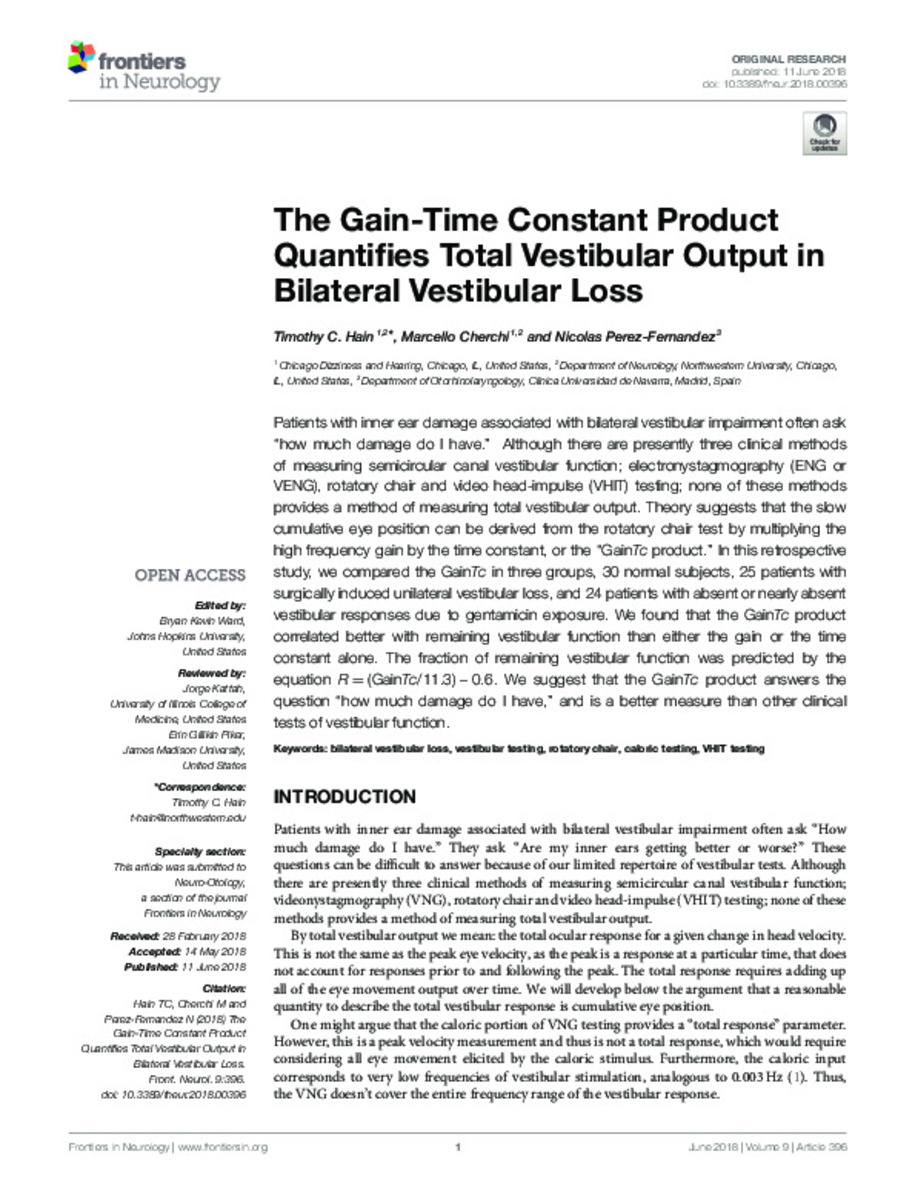Full metadata record
| DC Field | Value | Language |
|---|---|---|
| dc.creator | Hain, T.C. (Timothy C.) | - |
| dc.creator | Cherchi, M. (Marcelo) | - |
| dc.creator | Perez-Fernandez, N. (Nicolás) | - |
| dc.date.accessioned | 2023-02-21T12:28:50Z | - |
| dc.date.available | 2023-02-21T12:28:50Z | - |
| dc.date.issued | 2018 | - |
| dc.identifier.citation | Hain, T.C. (Timothy C.); Cherchi, M. (Marcelo); Perez-Fernandez, N. (Nicolás). "The gain-time constant product quantifies total vestibular output in bilateral vestibular loss". Frontiers in neurology. 9 (396), 2018, | es |
| dc.identifier.issn | 1664-2295 | - |
| dc.identifier.uri | https://hdl.handle.net/10171/65518 | - |
| dc.description.abstract | Patients with inner ear damage associated with bilateral vestibular impairment often ask “how much damage do I have.” Although there are presently three clinical methods of measuring semicircular canal vestibular function; electronystagmography (ENG or VENG), rotatory chair and video head-impulse (VHIT) testing; none of these methods provides a method of measuring total vestibular output. Theory suggests that the slow cumulative eye position can be derived from the rotatory chair test by multiplying the high frequency gain by the time constant, or the “GainTc product.” In this retrospective study, we compared the GainTc in three groups, 30 normal subjects, 25 patients with surgically induced unilateral vestibular loss, and 24 patients with absent or nearly absent vestibular responses due to gentamicin exposure. We found that the GainTc product correlated better with remaining vestibular function than either the gain or the time constant alone. The fraction of remaining vestibular function was predicted by the equation R = (GainTc/11.3) – 0.6. We suggest that the GainTc product answers the question “how much damage do I have,” and is a better measure than other clinical tests of vestibular function. | es_ES |
| dc.language.iso | eng | es_ES |
| dc.publisher | Frontiers | es_ES |
| dc.rights | info:eu-repo/semantics/openAccess | es_ES |
| dc.subject | Bilateral vestibular loss | es_ES |
| dc.subject | Vestibular testing | es_ES |
| dc.subject | Rotatory chair | es_ES |
| dc.subject | Caloric testing | es_ES |
| dc.subject | VHIT testing | es_ES |
| dc.title | The gain-time constant product quantifies total vestibular output in bilateral vestibular loss | es_ES |
| dc.type | info:eu-repo/semantics/article | es_ES |
| dc.description.note | This is an open-access article distributed under the terms of the Creative Commons Attribution License (CC BY). The use, distribution or reproduction in other forums is permitted, provided the original author(s) and the copyright owner are credited and that the original publication in this journal is cited, in accordance with accepted academic practice. No use, distribution or reproduction is permitted which does not comply with these terms. | es_ES |
| dc.identifier.doi | 10.3389/fneur.2018.00396 | - |
| dadun.citation.number | 396 | es_ES |
| dadun.citation.publicationName | Frontiers in neurology | es_ES |
| dadun.citation.volume | 9 | es_ES |
Files in This Item:
Statistics and impact
Items in Dadun are protected by copyright, with all rights reserved, unless otherwise indicated.






